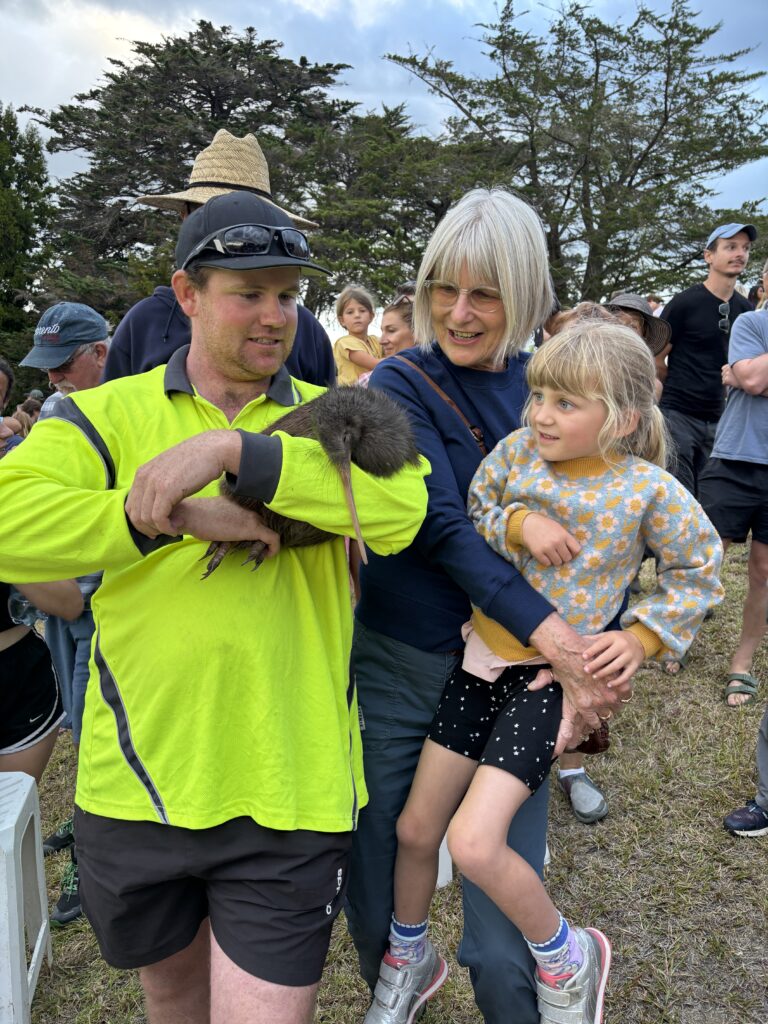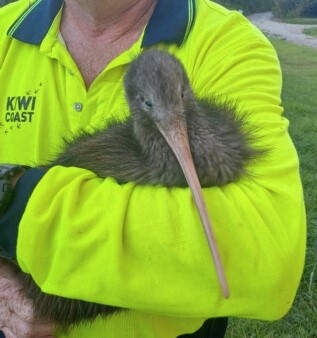Four more Northland brown kiwi have successfully graduated from their island creche and returned to the Whangarei mainland.
Led by Backyard Kiwi, the transfer and release of the wild kiwi was a huge collaborative effort from dawn till dusk involving hapū Te Parawhau, the Friends of Matakohe Limestone Island, Kiwi Coast, Northland Regional Council and the Department of Conservation.
The four kiwi all grew up on the Matakohe-Limestone Island kiwi creche, after being transferred as chicks from the Whangarei Kiwi Sanctuary with support from Ngāti Hine. They were welcomed back to the mainland on Sunday morning by Onerahi locals and members of Te Parawhau hapū, who led the group in a naming ceremony and whakawātea.
Over 400 people came to see the four kiwi and enjoy the rare opportunity to briefly meet a wild kiwi up close before their evening release.

Photo: Carlyn Condon
Three of the four kiwi were female, with the fourth just a teenager with more growing to do till its gender can be determined.
One of the females was named “Ping’ by local wifi providers Uber, who have supported and sponsored the Friends of Matakohe-Limestone Island for over ten years.
Dr Dai Morgan, Biosecurity Partnerships Program Manager for Northland Regional Council, released Ping and named another one of the females Kim, after legendary mustelid researcher Professor Kim King from Waikato University.
Watch as Dai releases Ping into a puriri burrow
Dr Morgan said: “It was great to be able to honour Kim in this way after all the research she has done over many years which helped figure out the threat mustelids pose to kiwi, and how to successfully control them to boost kiwi chick survival in the wild.”
At the evening release, the unique evolutionary characteristics were explained, as were the key ways to keep kiwi safe and help them thrive.
Todd Hamilton summed it up “At Whangarei Heads our kiwi have gone from 80 to over 1185 in the past 20 years. There’s three key things that we need to keep doing to keep kiwi thriving – control our dogs, trap out the stoats and once every three years, pulse a toxin through the trapping networks like 1080 that can kill the trap-shy stoats. If we keep doing these things, our kiwi will continue to flourish into the future.”

Photo: Accredited kiwi handler, Bill Hamilton with Myra the kiwi before her release. (Carlyn Condon)
Each kiwi was fitted with a tiny radio transmitter to enable their movements and activity to be monitored remotely.
Kiwi Coast Coordinator Ngaire Sullivan said “It will be interesting to see where these kiwi wander and what they do next. We are working with communities, iwi and hapū within the Kiwi Link project to help them build a continuous kiwi-safe corridor of pest control in eastern Whangarei. We call this New Zealand’s first “kiwi corridor”, and it all starts by linking the communities and kiwi together again.”
Backyard Kiwi Project Manager Todd Hamilton was grateful for the support and funding received that made the kiwi release possible:
“Huge thanks to Ngati Hine, Purua farmers, Department of Conservation, FOMLI (the community group managing Limestone Island), Kiwi Coast, Northland Regional Council, Foundation North and others for their support of this program.”



